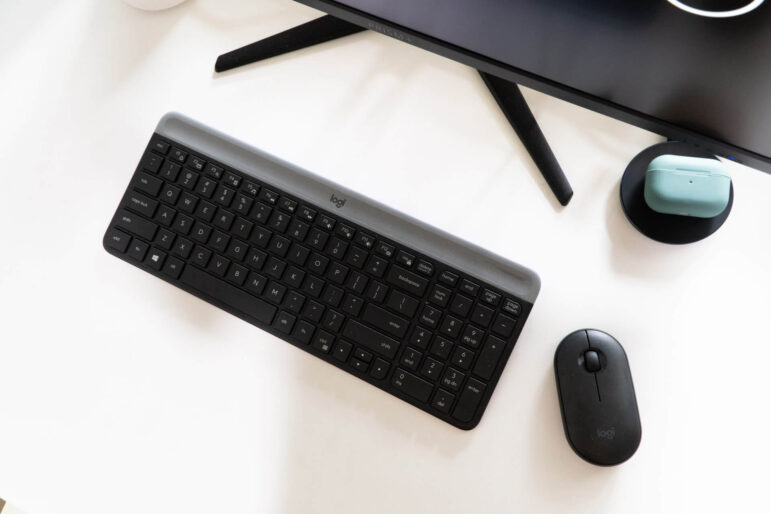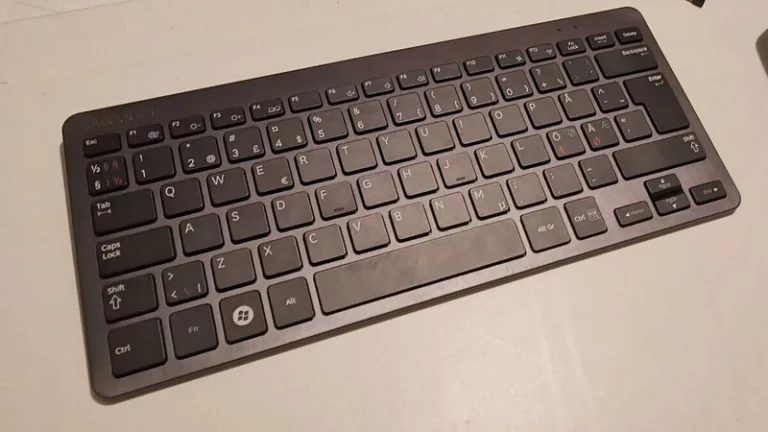How to Extend Wireless Range of a Wireless Keyboard and Mouse
If your wireless mouse or keyboard stops responding or starts skipping on the screen, it may mean that you are out of range.
If this is the case, fret not; this article will go over how to extend the range of a wireless keyboard and mouse!

How do Wireless Devices work?
Wireless gadgets have recently brought about a revolution in electronic devices. These useful inventions have made cables and cords littering your workspace a problem of the past. Nowadays, there is no need to be tethered to your desk in order to operate your Laptop or PC. Instead, the task can be done from a bed, couch, or anywhere else you please.
All this may bring to mind a question, how do these wireless keyboards and mice even work?
Essentially, wireless devices make use of radio frequencies for communication between the computer and the device. The wireless dongle that you plug into your PC acts a lot like an antenna or radio receiver on a satellite TV dish.
For example, whenever you strike a key on your wireless keyboard, the keyboard sends out a radio signal with information about which key has been pressed. This signal is received by the dongle and passed along to the computer. Thus, in this way, you are able to control your PC wirelessly from the other side of the room.
However, now that we have understood the functioning of these devices, a few questions also arise.
Why does my Wireless Keyboard or Mouse have low range?
Although many wireless devices on the market are advertised as having a 30-foot range, this rarely turns out to be the case. In fact, for most people, their wireless device stops functioning properly as soon as it is more than a few feet away from the PC.
This is a significant problem and can ruin the experience of using a wireless device. After all, the range may not even be long enough for you to move away from your desk!
It turns out that a few different factors can cause the reduced range commonly reported by many users.
Interference
One of the most common reasons behind the reduced range is interference. Just like waves on a lake, radio waves can also hit or ‘interfere’ with one another. This causes a loss of information, and thus, the signal from your device is not received by the dongle clearly.
Often, there can be many sources of interference within one’s workspace. These can include common objects like phones or tablets to larger appliances like microwaves and fridges. Having any of these nearby when you are trying to use a wireless device can cause interference and thus reduce range.
Low Power
Although your wireless keyboard or mouse has its own batteries that supply its power, the same is not true for the USB dongle that is connected to your PC or Laptop.
Usually, these dongles rely on the USB port for power to operate and receive signals. However, if there is a drop in power in the USB port, this can reduce your dongle’s performance and range.
This drop-in power is a frequent problem experienced in laptops. This is because the battery will try to conserve energy and thus not provide high power to the USB ports. Moreover, this issue can also be caused when there are many USB devices connected to the same laptop, and thus the voltage has to be split between all of them.
Low Quality
Recently, there has been a flood on the market of cheap and generic wireless keyboards and mice. Although some of these function perfectly well, many are poorly designed or have poor quality components that do not function as advertised.
Thus, if your wireless keyboard or mouse is from a particularly unknown brand, then it might have a low-quality antenna or receiver and thus is not able to work over longer ranges.
Out of Date Drivers
One of the most frequent causes of problems with computer hardware is out-of-date drivers. To understand why this is such a common problem, we must first understand what a driver is and what it does.
The driver is a piece of software in your computer that acts as a bridge between your accessories and your PC. Each wireless keyboard or mouse has its own driver, which communicates with the PC and helps ensure that seamless communication can take place between the dongle and the CPU(Central Processing Unit).
Sometimes, however, drivers can stop functioning correctly because of an issue with the code or general obsolescence. To counteract this, companies release new drivers frequently to ensure a smooth running of hardware.
If your driver has not had one of these updates in a long while, then the wireless keyboard or mouse can experience issues. These issues can vary in severity; sometimes, the device might stop functioning completely. Other times, your range may decrease, or you may experience the characteristic ‘skipping’ of the cursor on your screen.
How to extend the range of my Wireless Keyboard or Mouse?
Now that you are aware of the potential problems which could be leading to your devices’ short range, we can discuss the solutions to help solve these issues.
Removing Sources of Interference
The first thing that you should try is to remove all potential sources of interference. These include any devices that produce radio frequencies such as other laptops, garage remotes, and even some children’s toys such as walkie-talkies.
If possible, you should try to remove all such devices from the room in which you are using your PC or Laptop. If, however, for some reason, you cannot remove all these devices from the room, then you should try to ensure that these devices are not within a 6-foot radius of your dongle and computer.
Moreover, another thing to watch out for are Wifi routers or modems. Since Wifi signals are also a radio frequency, they can potentially interfere with the signals of your wireless device. Thus, you should place these devices far away from your PC and laptop. Additionally, if possible, an ethernet cable should be used to connect to the internet instead of a Wifi connection.
This step alone should increase your range significantly; however, if you still face issues, try some other suggested solutions.
Ensuring an Adequate Supply of Power
As we discussed earlier, a lack of power can severely restrict the range of your wireless keyboard and mouse. This is because the dongle cannot function as well as it needs to on a reduced voltage. This problem is particularly severe with laptops as the battery is constantly trying to reduce power consumption.
Thus, one thing you can do is plug your laptop into its charging cable while you are using your wireless devices. While the laptop is charging, it uses energy from the wall socket instead of the battery. Thus, your USB ports will provide more energy to your dongle and ensure better functioning.
If, however, plugging your laptop in is not an option, then you can try removing any other USB devices on the laptop. Accessories such as USB printers, webcams, or phone chargers can draw a lot of voltage from the USB port they are connected to, which leads to reduced energy in the other ports. Thus when you remove these devices, there will be more energy for the dongle to use. This can help significantly extend the range of your wireless device.
Lastly, one more thing you can try is changing your laptop’s power preset. Often laptops will have a power-saving mode as well as a high-performance mode. You should ensure that your laptop is not in the power saving mode and is set to the high-performance mode for maximum power output in the ports.
Changing Batteries
Much like how the dongle requires adequate power to function optimally, so too does the wireless device. Most wireless keyboards and mice use commercially available and replaceable batteries as a source of power. However, over time, these batteries can run low on energy which can cause a decrease in the range of the device.
Hence you should try replacing your old batteries with brand new ones. This way, not only will your dongle have adequate power, but so too will the wireless device itself. Thus you will be able to extend the range of your wireless keyboard or mouse.
Facing the Dongle
Radio waves, much like waves in water or light, travel in a specific direction. Generally speaking, if your dongle is oriented in the wrong direction, this can reduce range because most of the radio waves do not hit the dongle.
To fix this issue, simply make sure that the dongle and your wireless device are in line with each other. For example, if your wireless mouse is placed to the right-hand side of your laptop, then to maximize range, your dongle should also be attached to a USB port that is on the right-hand side of the laptop.
By following this method, you will establish a stronger connection between your computer and your wireless device, and thus, be able to increase range.
Updating your Drivers
As we discussed earlier, drivers play a crucial part in the proper functioning of any accessory with your computer. Due to this important role, drivers need to be frequently updated to ensure that the latest version is being used, free from bugs or glitches.
Unfortunately, however, all devices do not use the same driver, even though that would make updating them more straightforward. Instead, each device has its own drivers, depending on the model and manufacturer. Thus, to update your driver, you will have to look online for the driver that corresponds with your wireless keyboard or mouse model.
If your device is from a reputable and well-known brand, however, then the drivers can likely be updated easily from the manufacturer’s website.
Purchase a USB Extender
If your range is still not long enough after implementing all these suggestions, you should purchase a USB Extender.
The USB Extender is essentially a USB cable with a standard Type-A connector on one end but a USB port on the other end. This piece of hardware thus acts as a wireless mouse range extender/ wireless keyboard range extender.
There are many different versions of USB extenders available on the market. Each of these has a different length, and you can pick whichever length is adequate for you. For example, if you would like to extend your range by 15 feet, then a 15-foot long extender will be the right option for you.
Once you have purchased your extender, plug the USB connector end into your PC or laptop’s USB port. Then, on the other end of the extender, insert your dongle into the USB port. Once this has been done, simply bring the end of the extender connected with the dongle closer to where you want to use your wireless device from.
By doing this, you are essentially able to cheat the system. Instead of the radio waves from your wireless device having to travel the entire distance to wherever your laptop or PC is located, they can take a shortcut instead.
With the USB extender attached, the radio waves from your wireless device will only have to travel to the dongle. From here, the signals are received by the dongle and sent to your PC or laptop through the physical cable of the USB extender. Thus by this method, you are able to avoid interference or a loss of signal strength over longer distances.
What if these Solutions do not Work?
If your wireless device still does not have increased range despite all these attempts, then the problem may lie with the device itself. Your wireless keyboard or mouse may either have a faulty part or generally be of poor quality.
In such a case, you should seek to purchase a replacement device so that you can use your PC or laptop from the comfort of your couch!

Espen
Espen is the Director of ProPairing and has written extensively about Bluetooth devices for years. He is a consumer product expert and has personally tested Bluetooth devices for the last decade.






